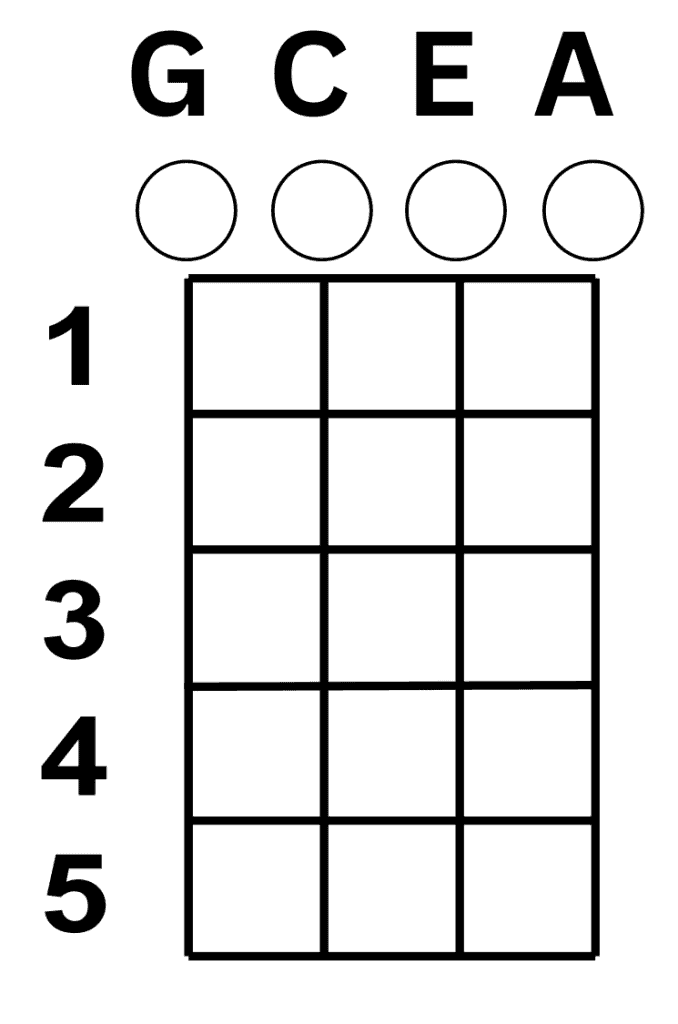The First 4 Ukulele Chords For Beginners
Learning the ukulele, one of the world’s most charming instruments, is exciting and rewarding. This article is your go-to guide for stepping into the world of ukulele music with ease, mainly focusing on basic uke chords essential for beginners.
You’ll learn the 4 chords that form the backbone of countless songs.
What Makes the Ukulele a Perfect Instrument for Beginners?
If you are new to music, the ukulele is an excellent instrument to begin your journey. Its small size makes it easy to handle, and mastering the basic chords is straightforward compared to other string instruments.
You can play many songs with just a few basic ukulele chords, and when you are starting out, this provides a sense of accomplishment that will fuel your learning journey.
How Do You Read a Ukulele Chord Diagram?
Chord diagrams are simple visual representations of the instruments’s fretboard, showing you where to place your fingers.
They appear as a grid, with vertical lines representing the strings G-C-E-A, and horizontal ones indicating the frets.
The top line of the grid mimics the ukulele’s nut, where the headstock meets the neck.
Dots on the grid show where to place your fingers, each dot correlating to a specific finger and fret. Reading chord diagrams is a foundational skill that will significantly aid your progress as a new ukulele player.

Ukulele Chords For Beginners: The 4 Chords You Should Learn First
The first few chords new ukulele players should learn are C, G, Am, and F.
These chords are the building blocks of so many songs, and they’re simple to play, requiring only one or two fingers.
They also provide the basis for understanding chord patterns and progressions in songs. By starting with these, you’ll be able to play hundreds of songs and adapt more quickly when learning new chord shapes.
How to Play the C Chord on the Ukulele: Step-by-Step
The C chord is often the first one to learn because of its simplicity. Here’s how to play it. First, hold your ukulele in a comfortable position.
Finger Placement:
- Place your ring finger on the third fret of the A string (the bottom string).
- Ensure your finger is just behind the fret, not on top of it.
- Strum all four strings at the same time with your other hand.
Congratulations, you’ve just played your first chord! The positioning might feel a bit awkward at first, but with practice, your fingers will find their places naturally.

Exploring the G Chord: Why Is It Important?
Finger Placement:
- Place your index finger on the A string second fret
- Your middle finger on the C string second fret
- Your ring finger on the E string third fret.
- Strum all four strings.
The G chord is pivotal in ukulele playing because it’s part of the common progression G-C-D, fundamental in a lot of western music.

How to Play A-Minor (Am) on the Ukulele
A minor (often abbreviated as Am) holds a distinctive place in music due to its somber sound, adding depth and emotional complexity to songs. For ukulele players, especially beginners, mastering Am is a rite of passage, unlocking the potential to play countless tunes.
Once again, begin by holding your ukulele comfortably, ensuring it is stable against your body.
Finger Placement: The beauty of the Am chord lies in its simplicity. You only need one finger—your middle finger.
- Place your middle finger on the second fret of the top G-string.
- Make sure your finger is pressing down just behind the fret (not on top of it), and it’s positioned in a way that it doesn’t touch or mute the adjacent strings.
- Strum all four strings.

Minor Chords: How Do They Differ?
Minor chords, often symbolized with an “m” (for example, “Am” for A minor), have a sadder sound than major chords. They’re created by lowering the third note of a scale, creating a moodier tone.
You will soon recognize the difference in sound between major and minor chords and understand how they are used to bring emotion and movement into the songs you play.
Learning the F Chord
Finger Placement:
- Place your index finger on the first fret of the E string (the second string from the top). Ensure that the fingertip is pressing the string down just behind the fret. This placement is crucial to avoid a buzzy sound.
- Position your middle finger on the second fret of the G string (the fourth string from the top). Like the index finger, ensure it is just behind the fret, providing enough pressure to create a clear sound.

Strumming the Ukulele: How Does It Work?
Strumming involves rhythmically hitting the strings with a finger or pick to produce sound. Focus on down-strums at the beat’s steady pace.
Hold the ukulele’s neck with your left hand (if you’re right-handed) and use your index finger on your right hand to strum the strings down from the G to the A string near the soundhole.
Choose a chord, and once your fingers are in place, strum all four strings simultaneously. Ensure you’re strumming from the top (closest to your head) down to the bottom string, and all strings vibrate freely to produce a clear sound. The strumming should be done in the area around the soundhole of your ukulele to produce the best sound.
Integrate Strumming Patterns: As you become comfortable, you can explore more complex strumming patterns and rhythms, adding richness to your playing.
Once you’re comfortable forming the 4 chords we’ve shown you here, practice transitioning between them and experimenting with different strumming patterns. This variation will add a rhythmic richness to your sound, making your playing more engaging.
Chord Transitions: How to Switch Chords Smoothly?
Practice Chord Transitions: The real music begins when you can transition between chords smoothly. Practice switching between Am and the other chords. An easy transition to try is C to Am, as it requires moving just one finger.
Smooth chord transitions are essential for maintaining rhythm and tempo. Start by practicing the chord shapes individually, then work on switching between them efficiently.
Tip: Use a metronome to practice at a consistent tempo, gradually increasing speed as you become more comfortable.
Additionally, minimize movement by keeping your fingers close to the fretboard and using pivot points, fingers that stay in the same place while others move to form new chords.
Which Songs Can You Play with the 4 Chords?
With just these chords, a whole repertoire of songs becomes available to you. Many popular songs use simple chord progressions.
“Somewhere Over the Rainbow” by Israel Kamakawiwo’ole, for example. “I’m Yours” by Jason Mraz is another favorite in the ukulele community, known for its catchy tune and simple chord structure. These songs are easy to pick up and fun to play and sing along with.
Practical Tips for New Ukulele Players
Regularly practicing the chords you’ve learned in this article will enhance muscle memory, making playing more intuitive over time. The 4 ukulele chords for beginners are just the start of your journey.
Here are a few tips:
- Ensure your ukulele is tuned correctly before playing.
- Start slow, prioritizing accuracy over speed.
- Practice in short, consistent sessions to build muscle memory.
- Don’t shy away from experimenting with different strumming patterns.
- Always warm up your fingers before practicing with simple exercises.
- Be patient and persistent; proficiency comes with practice.
Key Takeaways:
- Mastering the basic chords on the ukulele opens up a vast array of songs to play.
- Chord diagrams are essential tools to help you to learn new chords.
- Practice transitioning between chords to play songs more smoothly.
- Understanding the difference between major and minor chords adds emotional depth to your playing.
- Regular practice, patience, and passion are crucial components of your musical journey on the ukulele.

